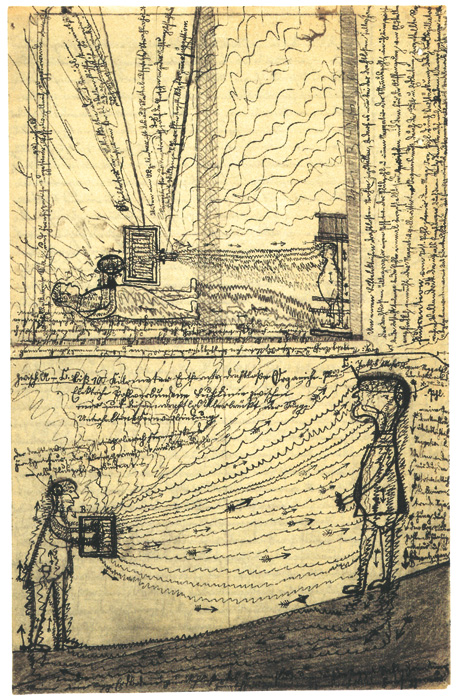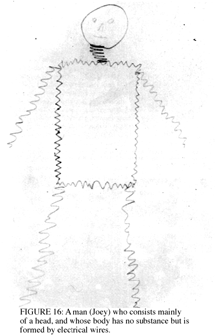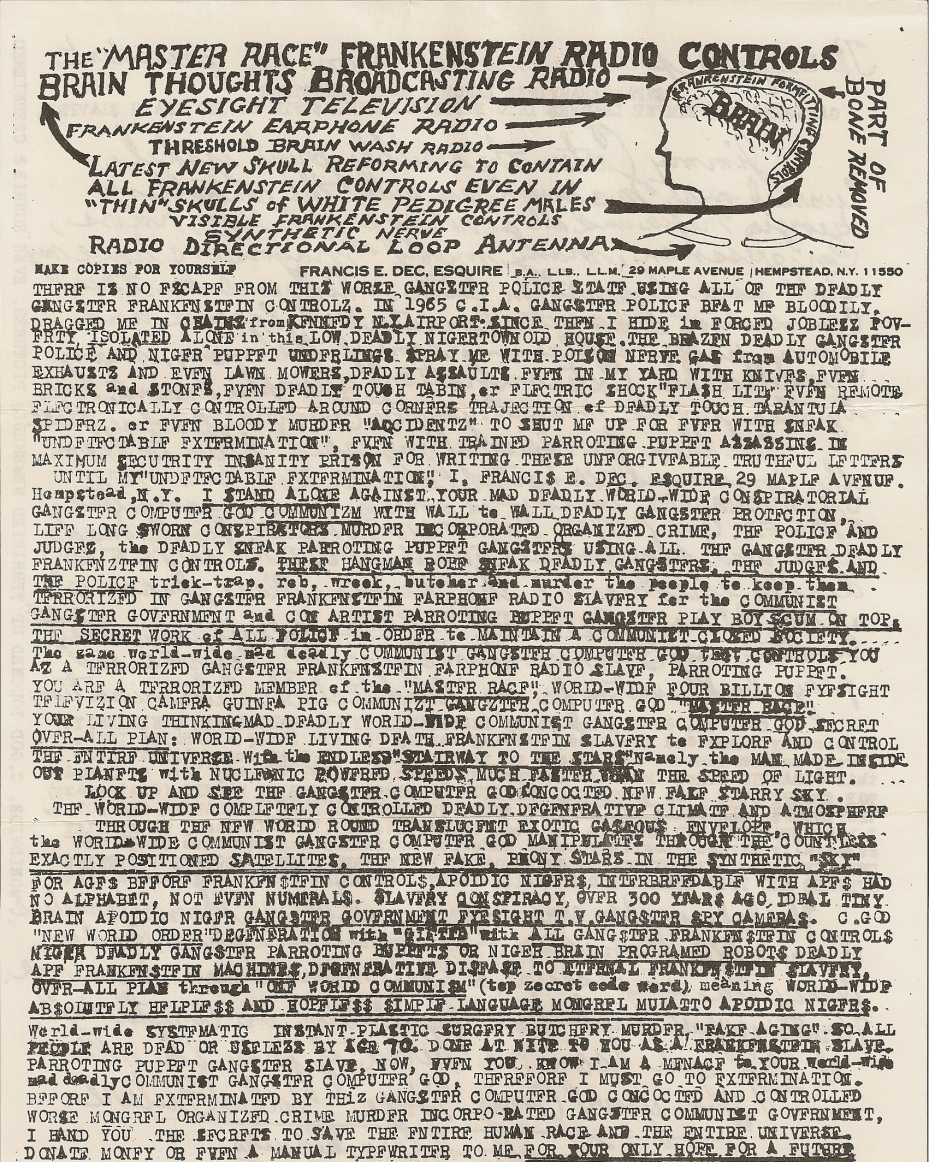User:Amy Suo Wu/notes, research and digressions: Difference between revisions
Amy Suo Wu (talk | contribs) |
Amy Suo Wu (talk | contribs) No edit summary |
||
| Line 1: | Line 1: | ||
== | == hybrid realities == | ||
In the third memory (1999), by Pierre Huyghe, the interplay between fiction and reality are blurred and have become hybridized. John Wotjtowicz watches the movie The Godfather staring Al Pacino. Inspired, he commits a bank robbery in 1972 only to have, Al Pacino star in another movie, Dog Day Afternoon (1975) based on the real story of John and the surrounding event that had been inspired by The Godfather. Beyond the beginning of this loop, what inspired the making of the Godfather? Was it a real or an imagined event or chain of events? It is realities' flimsy and shape-shifting properties that are for me a source of infinite fascination. For me, reality and fiction are interchangeable, fluid and continuous like the Ouroboros who eats his own tail. [http://www.hollanddoc.nl/kijk-luister/maatschappij/misdaad-en-straf.html?playurn=urn:vpro:media:program:3184279¤tPage=1 Here ], Dutch film maker tries to make a documentary about 'a truth being so strange that it becomes a super fiction' | In the third memory (1999), by Pierre Huyghe, the interplay between fiction and reality are blurred and have become hybridized. John Wotjtowicz watches the movie The Godfather staring Al Pacino. Inspired, he commits a bank robbery in 1972 only to have, Al Pacino star in another movie, Dog Day Afternoon (1975) based on the real story of John and the surrounding event that had been inspired by The Godfather. Beyond the beginning of this loop, what inspired the making of the Godfather? Was it a real or an imagined event or chain of events? It is realities' flimsy and shape-shifting properties that are for me a source of infinite fascination. For me, reality and fiction are interchangeable, fluid and continuous like the Ouroboros who eats his own tail. [http://www.hollanddoc.nl/kijk-luister/maatschappij/misdaad-en-straf.html?playurn=urn:vpro:media:program:3184279¤tPage=1 Here ], Dutch film maker tries to make a documentary about 'a truth being so strange that it becomes a super fiction' | ||
| Line 9: | Line 9: | ||
== | ==questions, possibilities == | ||
*where do the memories of these images come from? | *where do the memories of these images come from? | ||
*realities are re-mediated as a result of fluctuations and movements between fiction and/to reality and imagination and/to memory. | *realities are re-mediated as a result of fluctuations and movements between fiction and/to reality and imagination and/to memory. | ||
| Line 34: | Line 34: | ||
* 4. It creates sensations that in part cannot be described, because they are strange to the patient himself, and that in part are sensed as electrical, magnetic, or due to air-currents. | * 4. It creates sensations that in part cannot be described, because they are strange to the patient himself, and that in part are sensed as electrical, magnetic, or due to air-currents. | ||
* 5. It is also responsible for other occurrences in the patient's body, such as cutaneous eruptions, abscesses, or other pathological processes. | * 5. It is also responsible for other occurrences in the patient's body, such as cutaneous eruptions, abscesses, or other pathological processes. | ||
*[http://www.roddickinson.net/pages/airloom/project-synopsis.php The Air Loom, A Human Influencing Machine, 2002, Rod Dickinson] | *[http://www.roddickinson.net/pages/airloom/project-synopsis.php The Air Loom, A Human Influencing Machine, 2002, Rod Dickinson] | ||
| Line 42: | Line 43: | ||
== | == curious case studies == | ||
[[File:Turner 2.jpg]] | |||
* Jakob Mohr | |||
It was during this period, too, that the artwork of patients undergoing similar experiences began to be collected. Hans Prinzhorn preserved several works by Jacob Mohr, who was confined in Heidelberg’s psychiatric clinic in the years around 1910, producing extraordinary diagrams filled with black boxes radiating electric currents and hypnotic rays. In the scrambled but oddly techno-savvy text that accompanies them Mohr presents himself at some points as the omnipotent ‘Ruler of the World’, at others as the helpless victim of a ‘wireless-organic-positive-polar’ device that torments and paralyses him. - quoted from [http://mikejay.net/articles/the-art-of-mind-control/ this] article. | |||
[[File:Strang16.GIF]] | |||
* Joey the Mechanical Boy | * Joey the Mechanical Boy | ||
[[File:MRFRCrant.jpg]] | |||
* Francis E. Dec Esquire's influencing machine: The Worldwide Mad Deadly Gangster Computer God and its Gangster Computer God Worldwide Secret Containment policy. | |||
| Line 50: | Line 65: | ||
== more info / sources == | == more info / sources == | ||
Revision as of 14:16, 6 May 2011
hybrid realities
In the third memory (1999), by Pierre Huyghe, the interplay between fiction and reality are blurred and have become hybridized. John Wotjtowicz watches the movie The Godfather staring Al Pacino. Inspired, he commits a bank robbery in 1972 only to have, Al Pacino star in another movie, Dog Day Afternoon (1975) based on the real story of John and the surrounding event that had been inspired by The Godfather. Beyond the beginning of this loop, what inspired the making of the Godfather? Was it a real or an imagined event or chain of events? It is realities' flimsy and shape-shifting properties that are for me a source of infinite fascination. For me, reality and fiction are interchangeable, fluid and continuous like the Ouroboros who eats his own tail. Here , Dutch film maker tries to make a documentary about 'a truth being so strange that it becomes a super fiction'
Which bring me to think of "imagined" realities, dreams, daydreams and of hallucinations. Are these imaginary images a reflection of real events or do they come in from your subconscious, in the sense that hallucinations are perceived realities created in the negation of external stimulus. Made me think of events like landing of the moon and more recently the killing of Osama Bin Laden in which the authenticity of so-called "verifying" documents are challengable and suspicious. How do figments of peoples imagination enter into the realm of collective psyche and then reality until it enters into the stage of memory?
Artist Zoe Beloff is interested in mad women and mediums from last century. The work called 'Shadow Land or Light From the Other Side', is a based on the autobiography written in 1897 by a medium who was know to conjure up full body apparitions. In this work, she reanimates these spirits and shadows in 3D. The illusions are projected in the space and similar to 100 years ago, while the audience knew it was probably a clever trick, they believed it anyway. Interest in the paranormal and spiritualism that was highly popular during that time and had existed and circulated in the collective memory of even scientific men. She literally reanimates the images from the popular psyche of the public. The idea of re-enacting a collected hybrid reality or an imagined reality would be interesting.
questions, possibilities
- where do the memories of these images come from?
- realities are re-mediated as a result of fluctuations and movements between fiction and/to reality and imagination and/to memory.
- re-enacting/reconstructing images original sources that are of ambiguous nature and yet circulating in the collective memory.
example dream, daydream, hallucination, imagined realities. or of fake events (landing of the moon), myths, legends. illusions.
- resurrection? --> The War of the Worlds was re-enacted in 1938 by Orson Welles as a radio play. It supposedly caused panic and terror among the listeners due to the authenticity of the broadcasting.
- is consensual hallucination virtuality?
Influencing Machine: paranoid delusions, schizophrenia and alternate realities
On the Origin of the "Influencing Machine" in Schizophrenia is a highly influential article written by psychoanalyst Viktor Tausk. It was first published in the journal Psychoanalytic Quarterly in 1933. Rod Dickinson's work 'The Air loom' (2002) and Zoe Beloff's video installation 'The Influencing Machine of Miss Natalija A'(2001) were both inspired by the cases of people experiencing medical conditions of the now familiar belief of imagined mind control by an invented 'influencing machine'.
The paper describes Tausk's observations and psychoanalytic interpretation of a type of paranoid delusion that occurs in patients diagnosed with schizophrenia. The delusion often involves their being influenced by a 'diabolical machine', just outside the technical understanding of the victim, that influences them from afar. It was typically believed to be operated by a group of people who were persecuting the individual, whom Tausk suggested were "to the best of my knowledge, almost exclusively of the male sex" and are "predominantly physicians by whom the patient has been treated". - from wikipedia article
- extract from article (also from wikipedia)
The schizophrenic influencing machine is a machine of mystical nature. The patients are able to give only vague hints of its construction. It consists of boxes, cranks, levers, wheels, buttons, wires, batteries, and the like. Patients endeavor to discover the construction of the apparatus by means of their technical knowledge, and it appears that with the progressive popularization of the sciences, all the forces known to technology are utilized to explain the functioning of the apparatus. All the discoveries of mankind, however, are regarded as inadequate to explain the marvelous powers of this machine, by which the patients feel themselves persecuted. The main effects of the influencing machine are the following:
- 1. It makes the patient see pictures. When this is the case, the machine is generally a magic lantern or cinematograph. The pictures are seen on a single plane, on walls or windowpanes, and unlike typical visual hallucinations are not three dimensional.
- 2. It produces, as well as removes, thoughts and feelings by means of waves or rays or mysterious forces which the patient's knowledge of physics is inadequate to explain. In such cases, the machine is often called a 'suggestion-apparatus.' Its construction cannot be explained, but its function consists in the transmission or 'draining off' of thoughts and feelings by one or several persecutors.
- 3. It produces motor phenomena in the body, erections and seminal emissions, that are intended to deprive the patient of his male potency and weaken him. This is accomplished either by means of suggestion or by air-currents, electricity, magnetism, or X-rays.
- 4. It creates sensations that in part cannot be described, because they are strange to the patient himself, and that in part are sensed as electrical, magnetic, or due to air-currents.
- 5. It is also responsible for other occurrences in the patient's body, such as cutaneous eruptions, abscesses, or other pathological processes.
- The Air Loom, A Human Influencing Machine, 2002, Rod Dickinson
- Article about Miss Natalija A
- more info about video installation Miss Natalija A
- online version of Miss Natalija A
curious case studies
- Jakob Mohr
It was during this period, too, that the artwork of patients undergoing similar experiences began to be collected. Hans Prinzhorn preserved several works by Jacob Mohr, who was confined in Heidelberg’s psychiatric clinic in the years around 1910, producing extraordinary diagrams filled with black boxes radiating electric currents and hypnotic rays. In the scrambled but oddly techno-savvy text that accompanies them Mohr presents himself at some points as the omnipotent ‘Ruler of the World’, at others as the helpless victim of a ‘wireless-organic-positive-polar’ device that torments and paralyses him. - quoted from this article.
- Joey the Mechanical Boy
- Francis E. Dec Esquire's influencing machine: The Worldwide Mad Deadly Gangster Computer God and its Gangster Computer God Worldwide Secret Containment policy.



